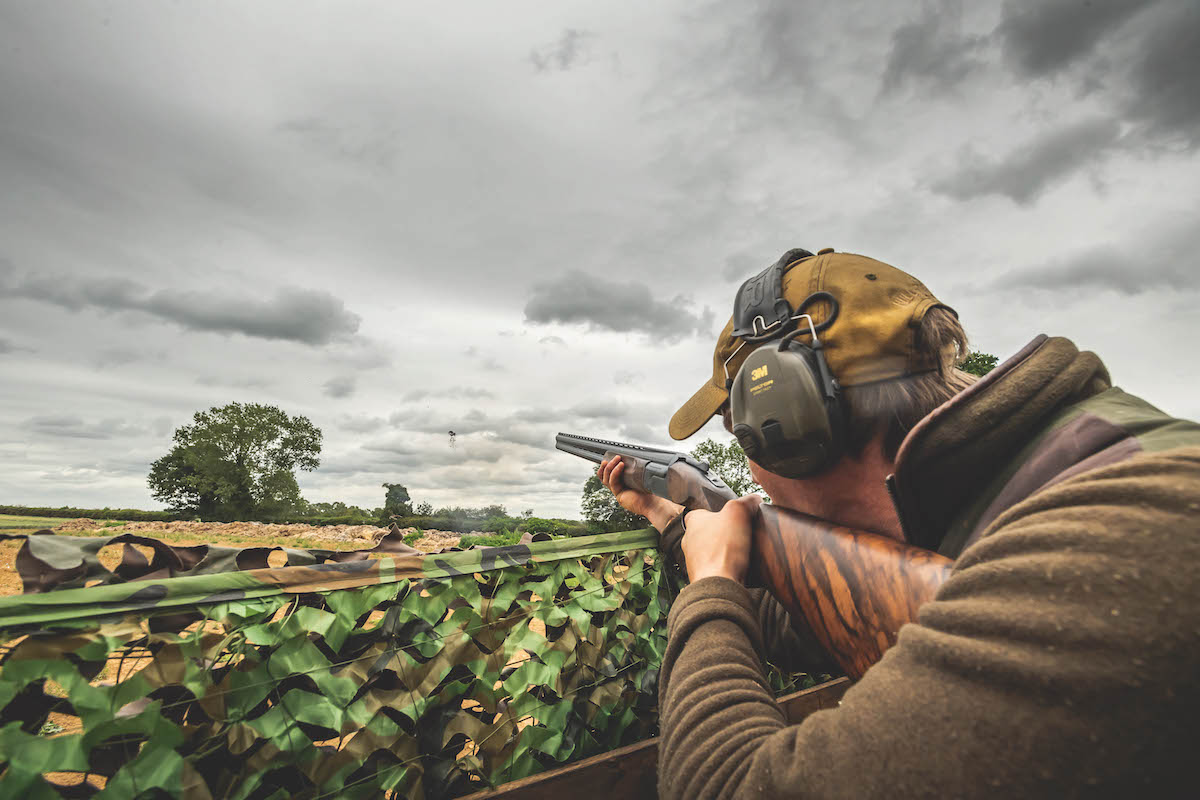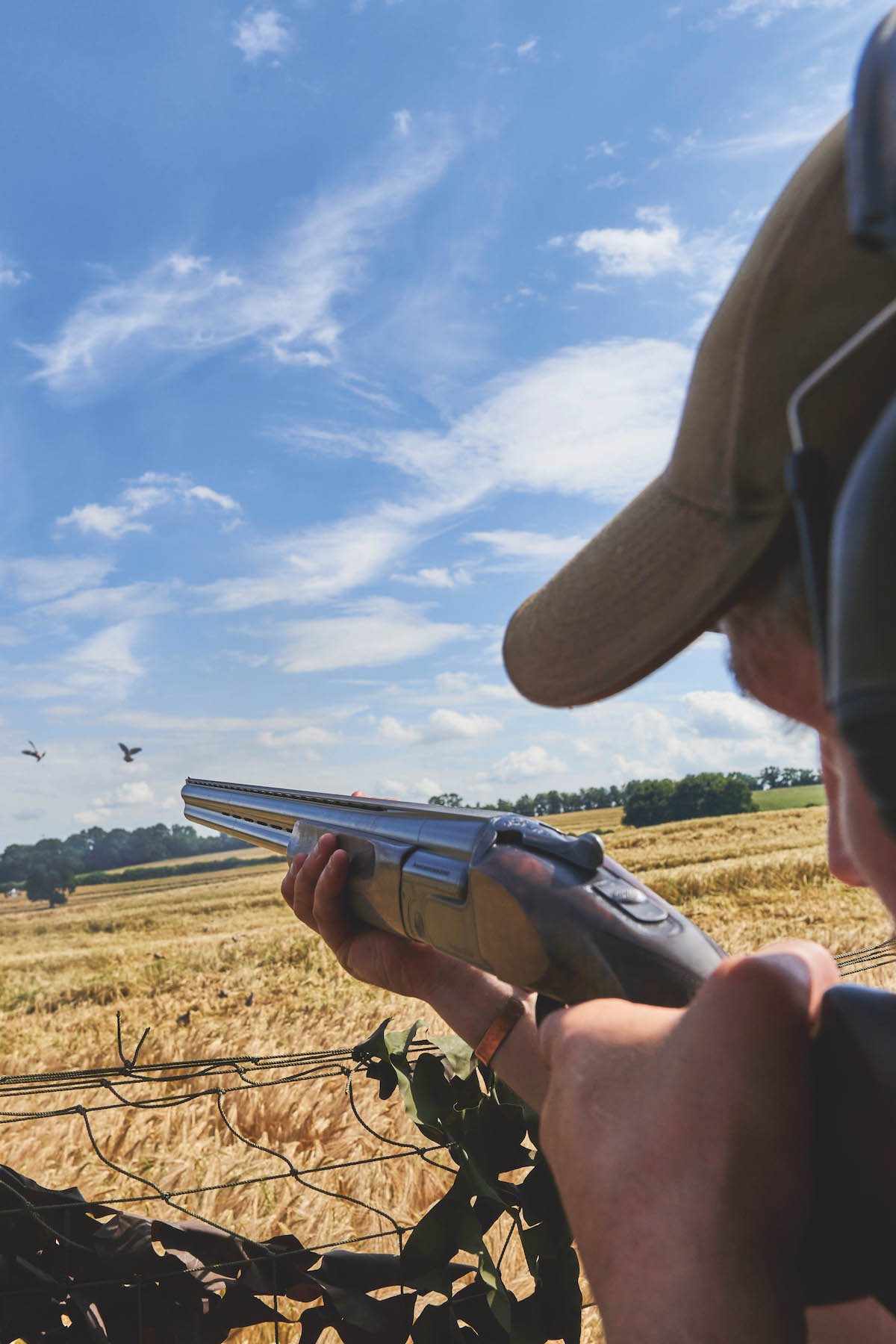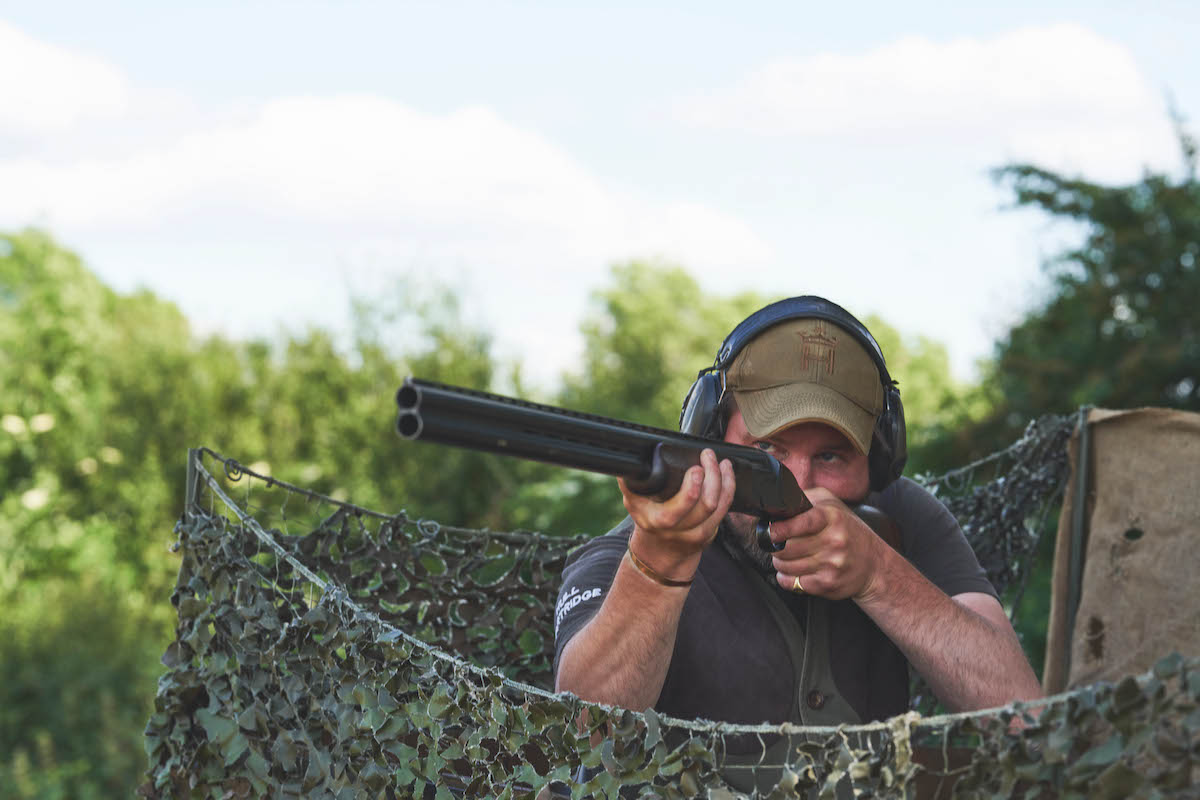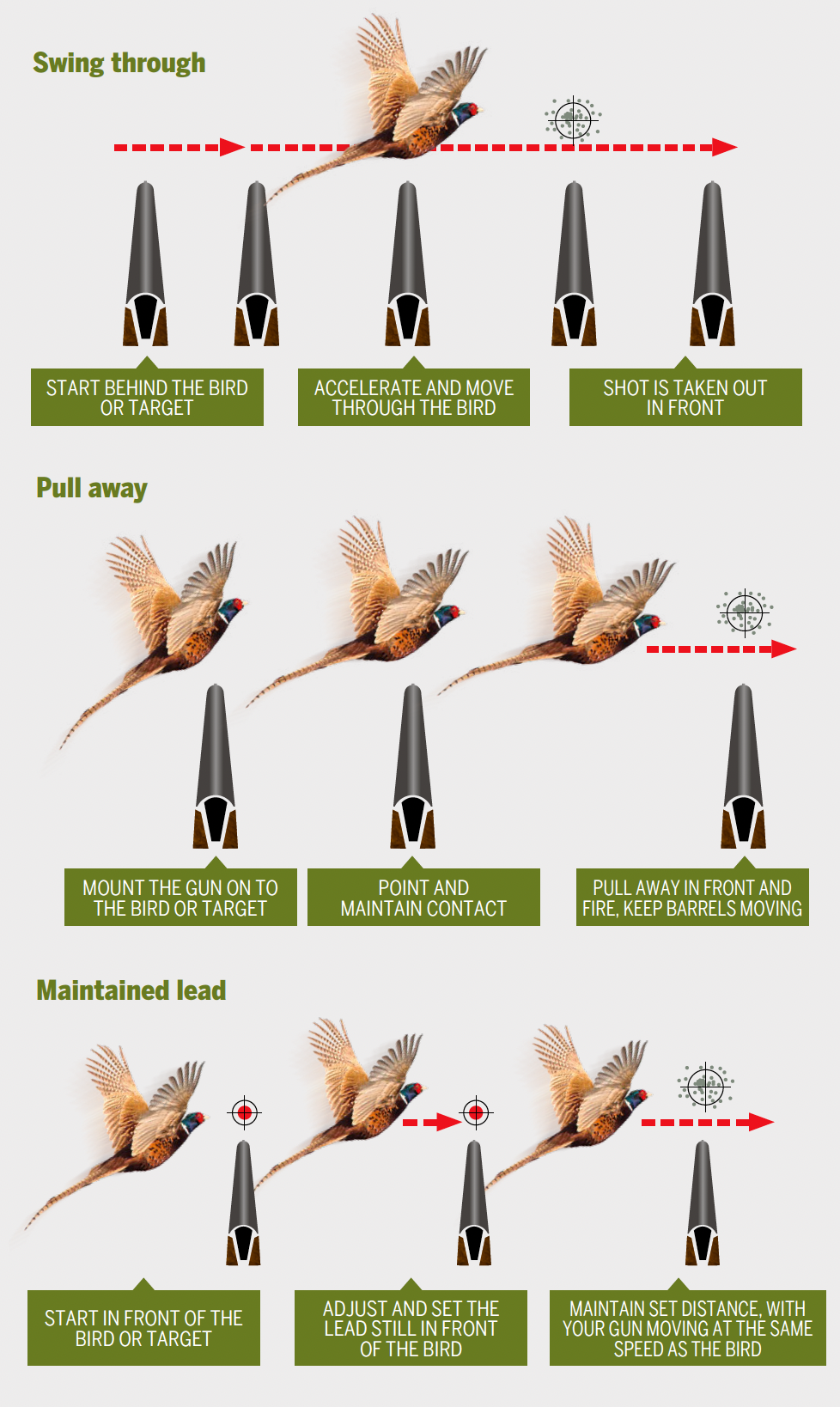Win CENS ProFlex DX5 earplugs worth £1,149 – enter here
Lead when shooting: here’s how to get it right
 Tom Payne shooting pigeons from the trailer hide
Tom Payne shooting pigeons from the trailer hide
How to get the right lead when shooting
We’ve all been there. You’re in the field on a shoot day and it’s simply not working out. “Give it more lead,” your pal tells you, and he should know — he did an instructor’s course and hasn’t stopped talking about everything he learned on it since (it was 12 years ago now). “Give it five feet,” he calls over from the next peg, “some of them need a five-bar gate’s worth.”
Lead, as in how far to shoot in front of a bird, as opposed to its homonym (Pb), which people won’t stop going on about at the moment either, is always a hot topic on the gun bus. If you’re not connecting, you’ll never be short of people who’ll tell you that you’re behind.
But to my mind, this obsession with the right lead when shooting often betrays a lack of experience, whether the person going on about it is another Gun or a supposedly seasoned instructor. To start with, shot leaves your barrels at 1,450ft per second — in other words, very, very quickly indeed. Back in the days of blackpowder, shot velocity was less than 1,000ft per second but these days you often just have to shoot at a bird’s beak or in front of a rabbit’s nose to kill it cleanly. I suspect, though, even in the heyday of Victorian shooting, gentlemen still regularly missed in front.

Be aware of the gap between your eyes, the gun and the bird you are trying to shoot
Where people go really wrong is when they start thinking about being in front of a bird rather than focusing on the bird itself. It is one of my greatest pleasures in life to take friends out in the pigeon hide — but I’m always amazed by how many people miss them in front. Over the years, I’ve observed that this is a particular issue when people go from shooting clays to live quarry — they get overexcited and start thinking that they need to double their lead. In truth, pheasants fly at around 40mph, which is often slower than a clay pigeon. When people get out on grouse, they go truly nuts and start tripling their lead.
Grouse, when they are close in, can seem like they are going very fast and are easy to over-lead
Personal differences
Everybody is different. And understanding that is essential — our eyes differ and the speed we swing our guns at also differs. Personally, when shooting standard Home Counties pheasants and partridges, up to around 30 to 35 yards, I don’t really see lead at all or, rather, I don’t have a perception of being in front of the bird. However, as I stretch out for longer birds I do become more aware of a gap between my eyes, the gun and the bird. That said, some 90% of my vision stays with the bird and I’m only aware of where the gun is in my peripheral vision.
When it comes to killing birds cleanly, what really matters is the initial connection with the bird, what most of us call the initial pick up, which begins with a good gun mount. You need to be watching the bird to connect with it, and your brain at that point will already be working the lead out for you. Trust your brain and your eyes — if you’ve shot enough, and even if you’re new to it, your brain is incredibly good at subconsciously working out lead. Mount the gun into the back of the bird or the target and move through it, then keep watching the bird until you pull the trigger and it folds in the air.
Nobody’s eyes are the same, and for this reason everybody will see something different; but it’s not just that your eyes will be different, it’s also your own personal body movement. Hand-eye coordination is a very individual trait. How our eyes, hands and body work is specific to us. One person’s five feet of lead is very different to another person’s, and gun speed is a very important factor. You want to match the speed of the target, which will put you on the right line, then you kill it by accelerating through. Your gun and body movement can also change depending on how you are feeling — if you’ve slept badly, you will often shoot much more poorly, as you lose fluidity. If you double your gun speed, you can kill just as effectively but clearly you’ll see less lead.
Tunnel your vision
Interestingly, if you start with your gun up (as in, you start with it in your shoulder), you’ll end up being very conscious of your barrels and you’ll see lead to a far greater degree — this is exacerbated by you tunnelling your vision, which means you’ll end up with a greater perception of lead. Equally, if you shoot with one eye closed (and some people have to) you will perceive lead more acutely — again, because you tunnel your vision and become more aware of the barrels.
Because common shooting lore maintains that when you’re missing you’re probably missing behind, there is a common issue in the field that when people hit a rocky patch during a drive they start increasing their lead and increasing their lead until they’re so far in front and usually so far off line that the birds have little to worry about. The right thing to do, of course, is to forget about lead and to go back to focusing on the bird. It’s a bit like cricket. Jonny Bairstow doesn’t just take a punt and stick his hands where he reckons the ball is going to go. His body and hand-eye coordination all respond to what the ball is doing.

Make sure you are watching the bird in order to connect with it, and trust your brain to help you out with lead
If we look at the three most common methods of lead when shooting: swing through, pull away and maintained lead, these will alter your perception of lead. For me, personally, I believe swing through to be the most effective on game, but make sure you don’t start too far behind the bird or you could miss the line. Again, it’s that connection. In the old days, people used to go on about the smoke trail method (imagine the bird is a plane, and come up through the smoke trail). Fair enough, but it’s easy to end up off line if you start too far behind the bird.
Pull away is very effective on closer-range birds as you need to shoot with a slower gun movement, but it can also be effective for most distances. Maintained lead (starting in front of the bird and maintaining the distance) is not something that I would recommend on game as it is very easy to misread the line if you don’t connect in the first place. A lot of clay shots shoot maintained lead, but they know exactly where the clay is going — the line is burned into their mind as they’ve done it a thousand times, while every live bird is different.
Eyes, technique and gun speed are such major and variable factors that it always amazes me the mathematical geniuses that can accurately determine how many feet an individual should be in front of the bird. There is no such thing as a bird that needs five feet. If you are catching a ball, you watch the ball and your hands and your body react accordingly. You don’t just stick your hands out and hope that the ball will land in them. That would be just thinking lead.
Of course, lead is a factor but lead is the end result to everything that you’ve done prior to the shot. Make the bird the priority and you will shoot more consistently. There are plenty of places to miss a bird and not just behind. Look that bird in the eye when you shoot it and I guarantee that you will have greater success than if you start thinking about where it’s going.
The methods and other errors
1. A bird at distance buys you time, but don’t mount too early. You want to shoot in a fluid motion. Mount when the bird is at 11 o’clock — go too early and you’ll check yourself.
2. Don’t panic and throw your gun out, guessing at the gap — the bird dictates everything so focus on it, mount behind in and watch it fold.
3. Don’t get into the habit of overleading and checking yourself — you’ll end up in the tricky situation of giving it too much, then ending up behind.
4. Close birds can feel like they are moving very fast. You basically have less time with a fast low-level grouse, for example. Don’t be fooled and suddenly think that because it seems faster due to it being closer it needs more lead.
5. Gun mount and foot work are paramount. Get these two things right and you’re 70% of the way there.
Related Articles
Get the latest news delivered direct to your door
Subscribe to Shooting Times & Country
Discover the ultimate companion for field sports enthusiasts with Shooting Times & Country Magazine, the UK’s leading weekly publication that has been at the forefront of shooting culture since 1882. Subscribers gain access to expert tips, comprehensive gear reviews, seasonal advice and a vibrant community of like-minded shooters.
Save on shop price when you subscribe with weekly issues featuring in-depth articles on gundog training, exclusive member offers and access to the digital back issue library. A Shooting Times & Country subscription is more than a magazine, don’t just read about the countryside; immerse yourself in its most authoritative and engaging publication.








